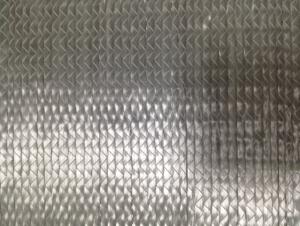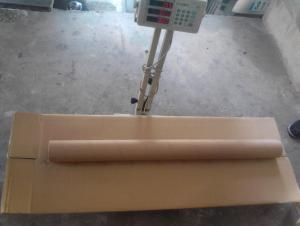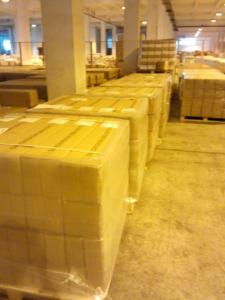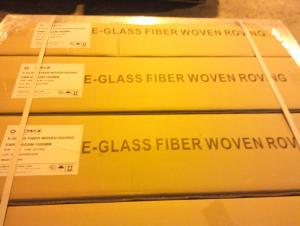HIGH QUALITY E-GLASS STITCH COMBO MAT-TTX
- Loading Port:
- China main port
- Payment Terms:
- TT or LC
- Min Order Qty:
- 1 kg
- Supply Capability:
- 100000 kg/month
OKorder Service Pledge
OKorder Financial Service
You Might Also Like
Brief Introduction: Fiberglass stitched combo mat (TTX)consists of two or more layers of fiberglass rovings which are stitch-bonded.one layer of rovings consists of parallel aligned roving and different layers of rovings can be oriented differently and have different linear density.The rovings specification,rovings orientation,number of rovings layers,mat width and roll diameter can be tailor-made according to customers' requirements. Characteristics 1. Manufactured by own factory SPECIFICATIONS
| ||||||||||||||||||||||||||||||||||||||||||||||||||||||||||||||||||||||||||||||||||||
FAQ
a.Pacage
Each Eglass stitched Combo Mat is wound onto a paper tube The roll is wrapped up with plastic film,and then packed in a cardboard box. The rolls can be vertically or horizontally placed. For transportation, the rolls can be loaded into a container directly or on pallets.
b.Product storage:
Unless otherwise specified, CHEMICAL FIBER GRIDDING CLOTH should be stored in a dry, cool and rain-proof area. It is recommended that the room temperature and humidity should be always maintained at 15℃~35℃ and 50%~75% respectively.
- Q:Can fiberglass fabrics be used for insulation in cryogenic storage tanks?
- Indeed, cryogenic storage tanks can utilize fiberglass fabrics for insulation purposes. Fiberglass, renowned for its low thermal conductivity and exceptional resistance to extreme temperatures, is a widely employed material for insulation. When it comes to cryogenic storage tanks, where maintaining materials at extremely low temperatures is crucial, fiberglass fabrics can serve as highly effective thermal insulation agents, minimizing heat transfer. These fabrics can be either applied as a layer or wrapped around the tank, effectively creating a barrier that hinders the escape of cold temperatures while also preventing the intrusion of external heat. Moreover, fiberglass fabrics possess the advantages of being lightweight and flexible, thereby facilitating their installation and handling in the construction and maintenance of cryogenic storage tanks.
- Q:What is the average thickness of fiberglass fabric?
- The average thickness of fiberglass fabric can vary depending on the specific application and manufacturing process. However, in general, fiberglass fabric typically ranges from 0.2 millimeters (0.008 inches) to 0.5 millimeters (0.02 inches) in thickness.
- Q:Can fiberglass fabric be used for making insulation tape?
- Insulation tape can indeed be made using fiberglass fabric. This fabric is renowned for its exceptional thermal insulation capabilities, thanks to its composition of woven glass fibers that can withstand high temperatures. These fabric tapes find widespread application across industries like electrical, automotive, and aerospace, serving to insulate and safeguard wires, cables, and pipes from heat and electrical currents. Typically, the fiberglass fabric is coated with a heat-resistant adhesive, enabling it to stick to different surfaces and establish a reliable insulation barrier. In conclusion, fiberglass fabric proves to be an appropriate option for manufacturing insulation tape due to its resistance to heat, durability, and versatility.
- Q:What is the abrasion resistance of fiberglass fabric?
- The abrasion resistance of fiberglass fabric is quite high. Due to its strong and durable nature, fiberglass fabric is known for its ability to withstand repeated friction and wear without significant damage. It is commonly used in applications where abrasion resistance is crucial, such as in the manufacturing of protective clothing, industrial curtains, and reinforcing materials for composites. The specific abrasion resistance of fiberglass fabric can vary depending on its construction, finish, and any additional coatings or treatments applied to the fabric. However, overall, fiberglass fabric is highly regarded for its excellent resistance to abrasion, making it a popular choice in industries where durability is essential.
- Q:Glass steel can be embedded parts
- Can be embedded normal.
- Q:Can fiberglass fabric be used for making insulation blankets?
- Indeed, insulation blankets can be manufactured using fiberglass fabric. Renowned for its remarkable thermal insulation qualities, fiberglass fabric proves to be a perfect material for crafting insulation blankets. These blankets are specifically engineered to confine heat and hinder its transmission, ensuring efficient insulation across diverse contexts like residential abodes, industrial environments, as well as aerospace and automotive sectors. Typically, the fiberglass fabric employed in insulation blankets is woven or knitted, rendering it supple and effortlessly modifiable to suit various shapes and dimensions. Moreover, fiberglass fabric exhibits traits of being lightweight, fireproof, and resistant to both chemicals and moisture, thereby establishing itself as a dependable option for insulation purposes.
- Q:Can fiberglass fabric be used for making surfboards?
- Yes, fiberglass fabric can be used for making surfboards. In fact, it is one of the most commonly used materials in surfboard construction. Fiberglass fabric is known for its strength, durability, and lightweight properties, making it an ideal choice for surfboard manufacturing. The fiberglass fabric is typically layered on the foam core of the surfboard and then laminated with resin to create a strong and rigid structure. This combination of materials provides the surfboard with the necessary strength to withstand the forces exerted by waves while maintaining flexibility for maneuverability. Additionally, fiberglass fabric allows for easy customization of the surfboard's shape and design, making it a popular choice among surfboard shapers and manufacturers.
- Q:Hello, could you tell me how to do the surface treatment under the glass fiber cloth? Thank you
- Conventional products are non heat treatment and heat treatment of two kinds, non thermal treatment of temperature resistant cloth, glass fiber color, temperature 550 degrees, the heat treatment of Neub is golden, temperature 700 degrees, can be used.
- Q:Can fiberglass fabrics be recycled or repurposed?
- Yes, fiberglass fabrics can be recycled or repurposed. Fiberglass is a versatile material that can be broken down and reused in various ways. One common method of recycling fiberglass is to grind it into a powder and then use it as a filler material in composite products such as concrete, insulation, or even new fiberglass products. This process reduces waste and allows for the reuse of fiberglass materials. Additionally, fiberglass fabrics can also be repurposed by cutting them into smaller pieces and using them for insulation or as reinforcement in other materials. These repurposed fabrics can be used for various applications such as automotive parts, boat repairs, or even art and craft projects. Overall, the recycling and repurposing of fiberglass fabrics help to minimize waste and make better use of this durable material.
- Q:Can fiberglass fabrics be used for insulation in industrial boilers?
- Indeed, insulation in industrial boilers can be accomplished by employing fiberglass fabrics. Fiberglass, renowned for its exceptional thermal resistance characteristics, is widely favored for insulation purposes across numerous domains. This lightweight and pliable material adeptly captures heat and thwarts its dispersion to the adjoining surroundings. In industrial boilers, fiberglass fabrics can be employed as insulating covers or jackets, thereby preserving heat within the system and heightening energy efficiency while minimizing heat dissipation. Furthermore, fiberglass boasts a non-combustible nature, rendering it a secure choice for insulation in high-temperature settings like industrial boilers.
1. Manufacturer Overview |
|
|---|---|
| Location | |
| Year Established | |
| Annual Output Value | |
| Main Markets | |
| Company Certifications | |
2. Manufacturer Certificates |
|
|---|---|
| a) Certification Name | |
| Range | |
| Reference | |
| Validity Period | |
3. Manufacturer Capability |
|
|---|---|
| a)Trade Capacity | |
| Nearest Port | |
| Export Percentage | |
| No.of Employees in Trade Department | |
| Language Spoken: | |
| b)Factory Information | |
| Factory Size: | |
| No. of Production Lines | |
| Contract Manufacturing | |
| Product Price Range | |
Send your message to us
HIGH QUALITY E-GLASS STITCH COMBO MAT-TTX
- Loading Port:
- China main port
- Payment Terms:
- TT or LC
- Min Order Qty:
- 1 kg
- Supply Capability:
- 100000 kg/month
OKorder Service Pledge
OKorder Financial Service
Similar products
New products
Hot products
Related keywords































